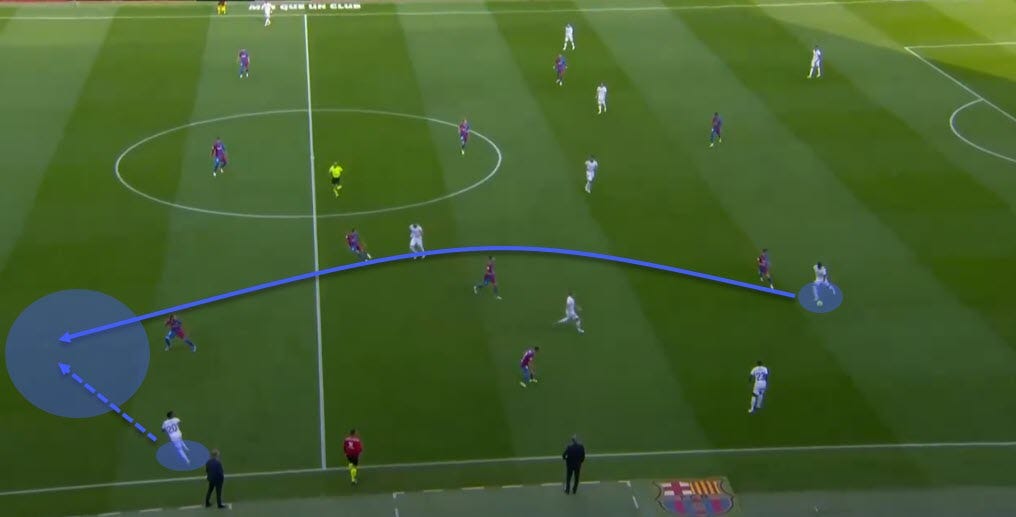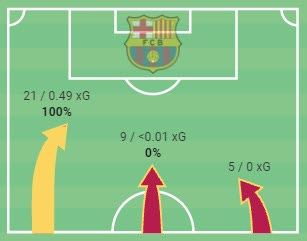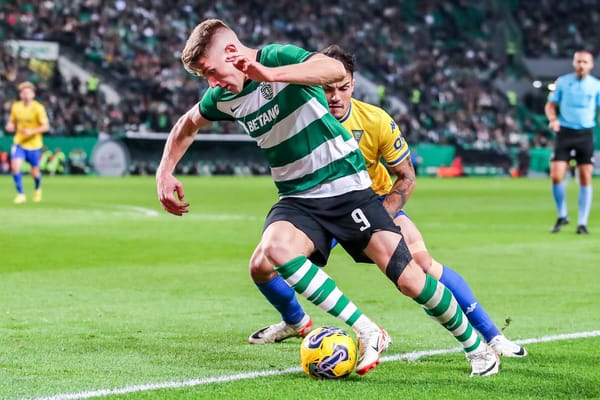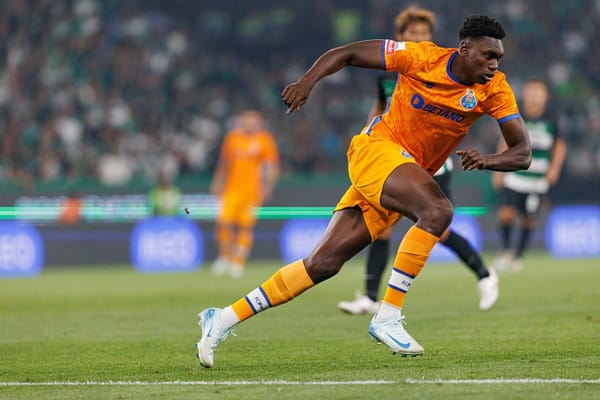Tactical analysis: Barcelona suffer another Clásico defeat
Barcelona lack difference-makers. Vinícius on his own made more dribbles than all of the Catalans’ forwards combined.


El Clásico is one of those games which can determine the fate of any given individual taking part in it, both on and off the pitch. People transcending into legends and heroes is as likely as plummeting down into the abyss, never to be seen again. And more often than not, it’s the game that changes the course of the season.
For Barcelona, a defeat was all but certain as far as the media, the pundits and even the fans were concerned. For the first time in maybe even two decades, the Catalans were the underdogs in a Clásico at the Camp Nou. Unfortunately, despite not playing as ones throughout the whole game, they couldn’t get the result in the end.
Ronald Koeman became the first Azulgrana coach in the last 85 years to lose his first three games against Real Madrid. On a similar note, more bad records were shattered. Barcelona lost two consecutive Camp Nou Clásicos for the first time since 1965 and for the first time since 1966, they’ve lost four consecutive ones in total.
“We didn’t deserve to lose. I don’t understand the result”, said Koeman after the game. But that’s the thing - he’s too focused on the result while completely disregarding the process. When asked about that same process and the performances, he continued by stating “slowly but surely, we’re improving. We’re coming close to winning a big game.”
To me, that screams like he’s approaching every game with a small team mindset, often blaming external factors for his inability to secure wins in big clashes. Needless to say, that is not a trait of a good coach. But credit where it’s due, we did see some improvement in yesterday’s bout.
Let’s dissect it a bit more.
The pressing scheme
Nowadays, it’s not often that we associate Barcelona with a good high press. Gerard Piqué spoke about it at length in his interview with El Pais, stating it’s not about the recovery pace or old age; it’s about the structure higher up the pitch. If that structure is unbalanced and leaky, the backline is the one that suffers and is forced deeper.
Barcelona’s defence is a relatively slow one if we disregard Jordi Alba, especially since he is usually positioned in the final third of the pitch and on the overlap. Piqué, Eric García and even Óscar Mingueza will always struggle to keep up with speedsters like, for instance, Vinícius Júnior. The same is true for Sergio Busquets.
If you force those players to compete in purely physical terms, relying on their sheer strength and speed to bail them out of a tricky situation, you’re going to suffer. A lot. And suffer they did against Real Madrid in particular. But in the first 50 minutes or so, Barcelona’s pressing scheme seemed… Improved. How so?

Above we can see one of their basic structures off the ball. It’s still very man-marking oriented, yes, but it’s also with a clear preference of certain areas. Barcelona were very particular in their timing and the way they pressed Real Madrid, leaving the flanks open on purpose.
Ansu Fati or Memphis Depay were the ones pressing from the front and tracking the ball while the second line stayed slightly deeper and focused on shutting down central channels. This would inevitably leave one centre-back and the full-backs free to receive the ball. But them doing so would also invite pressure from Barcelona’s first and second lines, who aimed to collapse quickly.
Throughout the first half, that strategy seemed to work but more so due to Real Madrid’s rather strange decision-making in possession. Yes, ultimately they were able to utilise Vinícius’ pace and trickery to wreak havoc but they seemed restrained on the ball.

Above you can see a very common sequence that Real should’ve been able to execute more often than they did. Alaba was given far too much space and time on the ball given his technical quality and isolating the wingers wasn’t a particular problem for Los Blancos.
Sure, Barcelona shut down the central channels well and were even able to collapse properly, especially on the right side, but the chances were there for the taking. So in a sense, while the pressing structure seemed improved, it was still a mixed bag when everything is put together.
Let’s look at another sequence that shows this much better. Again we see Barcelona leaving the flank open but now, Real Madrid make good use of it to escape the press.

And then, the lack of compactness in the structure combined with Real’s easy isolation of their main outlets results in a straightforward progression up the pitch. The attack slows down upon reaching the final third but it still goes to show how leaky Barcelona can be in defending those transitions.
Ultimately, the game ended up being a very transition heavy affair and that will always benefit the team with clear outlets. With Sergiño Dest underperforming and Fati still not being fully fit, Barcelona could only rely on Alba to do this effectively. And even then, they couldn’t make proper use of Real Madrid’s shaky defensive system, especially on that right side.
Contrast that to Los Blancos’ outlets in Vinícius and Rodrygo and you see there is a big difference between the two. But Barça’s attack lacked much more than just outlets.
It lacked clear ideas too.
(The lack of a) Plan to attack
Carlo Ancelotti came into the game knowing exactly what he needed to do to nullify this Barcelona - sit back, absorb the pressure and hit hard on the break. We’ve already analysed how they had all the weapons needed to execute such tactics. Considering Barcelona are also quite ineffective in breaking down mid and low blocks, this was a recipe for success for Los Blancos.
But how exactly did Koeman envision breaking through the opposition’s defensive structure? Coming into the game, we knew two things to be certain: Firstly, we knew Real would initially surrender the ball and let Barcelona beat themselves, as was the case with many Clásicos before this one. Secondly, as soon as the teamsheets were up, Real’s right side should’ve been identified as a weak spot.
Looking at Barcelona’s passmap below, we can say this was the case to an extent. The Catalans put a major focus on their left side but this would’ve been the case regardless of the defenders Real had deployed there.

The fact of the matter is, with Alba, Fati, Depay and even Frenkie De Jong, the left side of the pitch is much more dangerous than the right. This has been the case for many years now too. The introduction of Dest as a right-winger gives Barcelona width, yes, but no palpable threat, as was clearly visible from his 10-yard miss that could’ve completely changed the outlook of the game.
Of course, the American is not a finisher, that much we know. But a close-range attempt like that should at the very least be on target, regardless if the one taking it is a defender or an attacker by nature. The introduction of Sergi Roberto and Philippe Coutinho didn’t do much to enhance the right side of the pitch either.
Now, that doesn’t mean those substitutions were completely meaningless but they didn’t do much to diversify Barcelona’s offensive potential either. The following graph speaks for itself.

Coutinho’s introduction made Barcelona more central but it also meant the right side would remain completely ignored. Memphis and Fati interchanged positions multiple times throughout the game, to bigger or lower effects depending on the situation. For instance, Barcelona’s biggest chance of the game via Dest’s attempt was created through Memphis’ hold-up play in the central channels.
As opposed to Fati, the Dutchman can outmuscle defenders, turn them and then burst forward into space. That’s exactly what he’s done in that sequence too. But apart from the individual quality shining at times, Barcelona didn’t have a clear plan of attack. Lucas Vázquez may have been identified as a weak link but that was never fully exploited either.
It’s very concerning that 100% of Barcelona’s positional attack’s xG (expected goals) value has arrived from the left and yet, there wasn’t any real sense of threat for the majority of the clash. Not to mention that by failing to utilise the other flank offensively, it gave more freedom to Real Madrid’s left side of the pitch, namely to Vinícius who wasn’t too burdened by defensive responsibility.
Barcelona lack difference-makers. Vinícius on his own made more dribbles than all of the Catalans’ forwards combined. So with no clear roles in the forward line and the lack of individual difference-makers, Barcelona couldn’t hope to produce much. With the entrance of Luuk de Jong, their tactics boiled down to putting bodies and crosses into the box, ending the game with 22, only seven of which found their mark (31.82%).
And then, there’s the midfield, a seemingly crucial and yet, so dispensable cog of Barcelona’s machine. In theory, this is the core of the team but apart from Busquets, they also didn’t have clearly defined roles in possession.

Both interiors were largely uninvolved in the game, De Jong registering 50 passes (94% accuracy) and Gavi sitting on only 24 (79%). The latter was well controlled by Toni Kroos while the former was torn between having to be this deep-lying playmaker and a vertical outlet through the half-spaces. Sadly, he ended up doing neither particularly well.
As the heatmaps suggest too, the interiors were mostly used as cover behind the wingers/full-backs and in helping the first phase of build-up. Once the game became this transition-heavy affair, the midfield was sadly irrelevant altogether. De Jong was tasked with dropping deeper to open additional passing channels and then combine with the left side of Barcelona’s attack, namely Fati, Alba and Memphis.
But apart from being that recycler, a connection between the thirds if you will, and a dummy runner, the Dutchman was largely unremarkable and frankly, invisible. Whether that’s got to do with his run of form or a larger, collective issue at a system level is still up for debate but at the moment, for all his talent and potential, De Jong is being heavily underutilised.

This, of course, is a great shame and it remains to be seen whether Koeman truly is the one to get the best out of the midfielder. At the end of the day, the result is all that matters but the underlying issues of underperformance remain as a major flaw in Barcelona’s tactics.
Koeman is yet to tally a win over his top rivals and the excuses he's using are slowly running out, as is his time in the hot seat. How long is Joan Laporta going to let this rollercoaster go on is yet to be answered.
But the sooner Barcelona start making some serious changes, the better.




